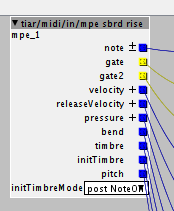(This relates to previous posts here and here, but since it's not the main concern of either thread, I'll start a new topic.)
I am still having diffulty getting the correct initial cc74 (timbre/glide) value from the Seaboard Rise MPE keyboard. The Seaboard sends a cc74 message right before the key-on message*, so that the note starts with the correct timbre value (it then sends further cc74s while the key is pressed if the position of the finger changes).
However, that value is not outputted by the mpe keyboard object, nor is it read into the _timbre variable in Smashed Transistor's modified mpe keyboard object (axoloti-contrib/objects/tiar/midi/in/mpe sbrd rise)
As a consequence one often gets ugly glitches from the cc74 value at the end of the previous note to the real one shortly after the key press. It also leads to completely wrong `initTimbre' with Smashed T's object.
I suspect this has to do with the voice allocation of axoloti polyphonic patches. At any rate I noticed that a midi monitor placed in the main patch correctly displays the pre-note-on cc74 message, but the same monitor placed within the polyphonic subpatch only shows cc74s after the key-on message.
Long story (sorry!) short: Anyone have a workaround for this? Or better yet: Am I missing something?
Thanks & cheers!
*at least most of the time; I'd be happy to get those cases to work properly and deal with the outliers later...


 ]
]
 ]
]



